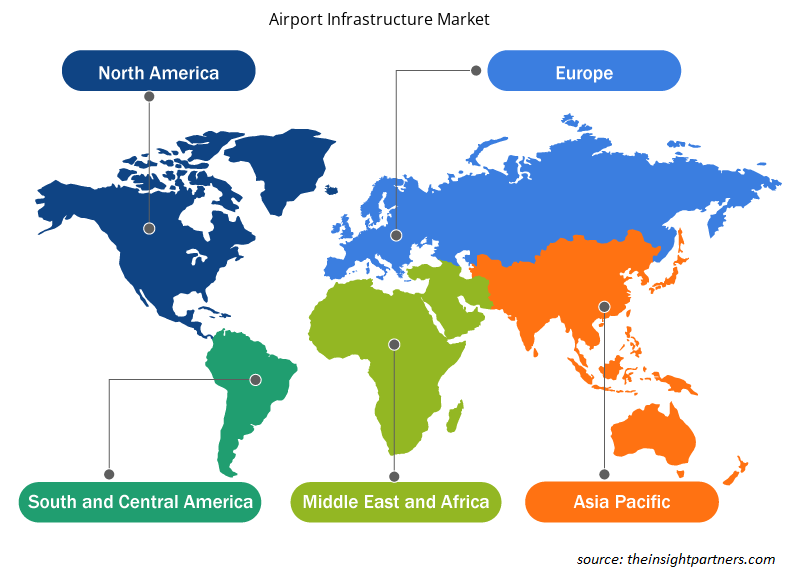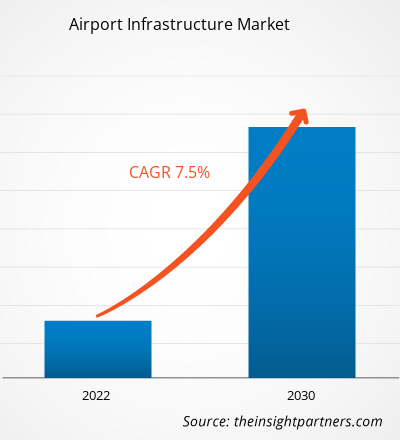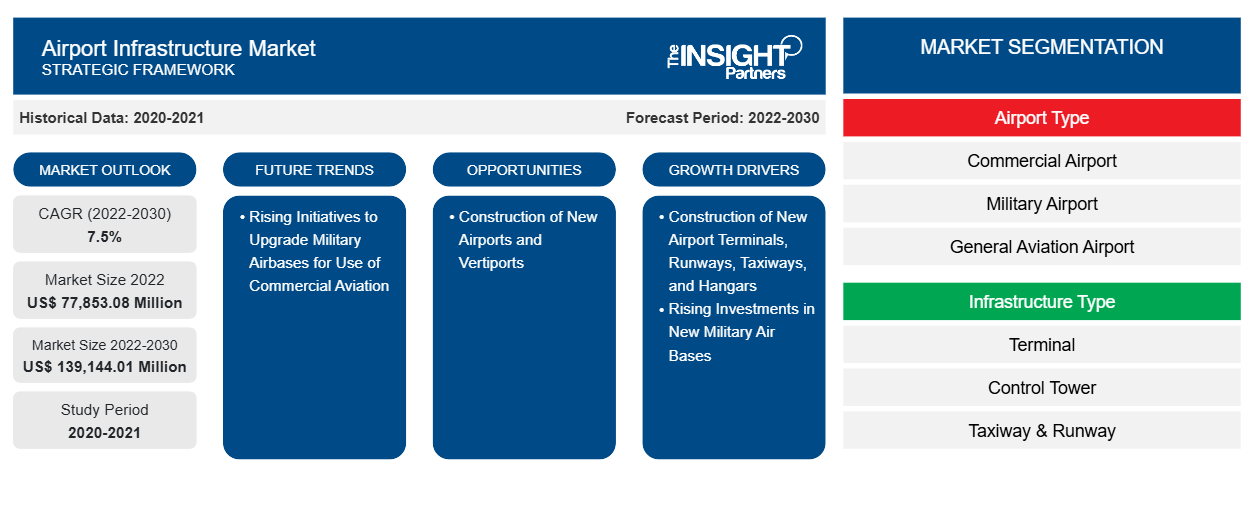Der Markt für Flughafeninfrastruktur soll von 77.853,08 Millionen US-Dollar im Jahr 2022 auf 139.144,01 Millionen US-Dollar im Jahr 2030 wachsen. Der Markt soll in den Jahren 2022–2030 eine durchschnittliche jährliche Wachstumsrate (CAGR) von 7,5 % verzeichnen. Regierungen verschiedener Länder haben Initiativen zum Bau neuer Flughäfen ergriffen, um der steigenden Zahl von Flugzeugflotten und Passagieren gerecht zu werden. So kündigte die indische Regierung im Jahr 2022 ihre Pläne an, bis Ende 2025 220 kommerzielle Flughäfen zu bauen. Darüber hinaus kündigte die Zivilluftfahrtbehörde der Volksrepublik China (CAAC) im Jahr 2018 ihre Pläne an, bis Ende 2035 216 neue Flughäfen zu bauen, wodurch sich die Gesamtzahl der Flughäfen bis 2035 auf 450 erhöhen wird (derzeit sind es 234 Flughäfen im Jahr 2023). Solche Entwicklungen haben das Wachstum des Marktes für Flughafeninfrastruktur für das Segment der kommerziellen Flughäfen weltweit vorangetrieben.
Flughafeninfrastruktur-Marktanalyse
Die Nachfrage nach Militärflughäfen und neuen Luftwaffenstützpunkten steigt aufgrund der zunehmenden globalen Spannungen zwischen Ländern verschiedener Regionen. Viele Länder haben ihre jeweiligen Militärinvestitionen für die Beschaffung missionsbezogener Technologien und den Bau neuer Stützpunkte an ihren jeweiligen Zielorten vorangetrieben. Darüber hinaus hat die Erweiterung bestehender Militärflughäfen, um eine größere Anzahl von Militärflugzeugen aufzunehmen, das Wachstum des Flughafeninfrastrukturmarktes für das Militärflughafensegment weltweit vorangetrieben. So gab die chinesische Regierung im September 2021 bekannt, dass in den Provinzen Tibet und Xinjiang 30 neue Flughäfen gebaut worden seien, um die zivile und militärische Flughafeninfrastruktur in den Regionen zu stärken. Darüber hinaus sind auch die zuvor angekündigten Pläne des indischen Militärs zum Bau von 59 Flughäfen in Arbeit. Bis Ende November 2023 verfügte Indien über ~39 Militärflughäfen für den jeweiligen Einsatz. Solche Entwicklungen haben das Wachstum des Flughafeninfrastrukturmarktes für das Militärflughafensegment vorangetrieben .
Marktübersicht für Flughafeninfrastruktur
Der Flughafen der allgemeinen Luftfahrt ist im Wesentlichen auf Geschäftsflugzeuge, Flugzeuge mit Kolbenmotor, Hubschrauber und Schulflugzeuge für Operationen wie Start, Landung, MRO-Dienste, Betriebsprüfungen und private Charterflüge ausgerichtet. Mehrere Länder, wie die USA, China, Russland und Großbritannien, verfügen bereits über eine größere Anzahl von Flughäfen der allgemeinen Luftfahrt, was das Wachstum des Marktes für Flughafeninfrastruktur für das Segment der Flughäfen der allgemeinen Luftfahrt durch Flughafenerweiterungsprojekte in ihren jeweiligen Regionen vorantreibt. So kündigte beispielsweise im September 2023 einer der größten Flughäfen der allgemeinen Luftfahrt (San Carlos Airport) in der San Francisco Bay Area, USA, Investitionen für Flughafenmodernisierungen mit 50.000 Quadratfuß neuer Hangarfläche und weiteren 22.000 Quadratfuß Gemeinschaftsfläche, Büroflächen und Besprechungsräumen an. Darüber hinaus eröffnete der Indira Gandhi International Airport in Delhi im Jahr 2020 auch ein neues Terminal für den Betrieb von Geschäftsflugzeugen. Solche Entwicklungen haben das Wachstum des Marktes für Flughafeninfrastruktur für das Segment der Flughäfen der allgemeinen Luftfahrt vorangetrieben.
Passen Sie diesen Bericht Ihren Anforderungen an
Sie erhalten kostenlose Anpassungen an jedem Bericht, einschließlich Teilen dieses Berichts oder einer Analyse auf Länderebene, eines Excel-Datenpakets sowie tolle Angebote und Rabatte für Start-ups und Universitäten.
-
Holen Sie sich die wichtigsten Markttrends aus diesem Bericht.Dieses KOSTENLOSE Beispiel umfasst eine Datenanalyse von Markttrends bis hin zu Schätzungen und Prognosen.
Treiber und Chancen auf dem Flughafeninfrastrukturmarkt
Zunehmender Bau neuer Flughafenterminals, Start- und Landebahnen, Rollwege und Hangars
Die wachsende globale Flotte kommerzieller Flugzeuge ist einer der Hauptfaktoren, die die Nachfrage nach neuen Flügen, Terminals, Start- und Landebahnen und Hangars an verschiedenen Flughäfen erzeugen, um dem wachsenden Passagierverkehr weltweit gerecht zu werden. Dies steigert auch die Investitionen der Flughafenbehörden in die Modernisierung ihrer jeweiligen Flughafenanlagen, um eine größere Anzahl von Flugzeugen aufnehmen zu können, was auch die Betriebseffizienz des gesamten Flughafens verbessert. Dies wird auch durch die Einführung von Billigfluggesellschaften unterstützt, die den weltweiten Fluggastverkehr unterstützt haben. Im März 2023 gab der kanadische Stadtrat von Kelowna die Genehmigung einer Finanzierung von 90 Millionen US-Dollar für das Erweiterungsprojekt des Kelowna Airport-Terminals bekannt. Mehrere Regierungsbehörden verschiedener Länder planen ebenfalls den Bau neuer Flughäfen in ihren jeweiligen Ländern, um den Fluss des internationalen Frachthandels und der Flugreisebranche zu verbessern. In den USA beispielsweise werden derzeit sechs neue Flughäfen gebaut. Außerdem kündigte die indische Regierung im Jahr 2022 ihre Pläne an, bis Ende 2025 220 Flughäfen zu bauen. Darüber hinaus kündigte die Zivilluftfahrtbehörde der Volksrepublik China (CAAC) im Jahr 2018 ihre Pläne an, bis Ende 2035 216 neue Flughäfen zu bauen und die Gesamtzahl der Flughäfen bis 2035 voraussichtlich auf 450 Flughäfen zu erhöhen (derzeit sind es 234 Flughäfen im Jahr 2023). Somit trägt der Bau neuer Flughafenterminals, Start- und Landebahnen, Rollbahnen und Hangars zum Wachstum des Flughafeninfrastrukturmarktes weltweit bei.Kelowna City Council announced approval for funding of US$ 90 million for the expansion project of the Kelowna Airport terminal. Several government authorities of different countries have also been planning to construct new airports across their respective countries to enhance the flow of international cargo trade and the air travel industry. For instance, in the US, six new airports are currently under construction. Also, in 2022, the Government of India announced its plans to build 220 airports by the end of 2025. Moreover, in 2018, the Civil Aviation Administration of China (CAAC) announced its plans to construct 216 new airports by the end of 2035 and is likely to boost the total airport count to 450 airports by 2035 (234 airports currently in 2023). Thus, the construction of new airport terminals, runways, taxiways, and hangars contributes to the growth of the airport infrastructure market across the globe.
Zunehmende Initiativen zur Modernisierung militärischer Flugplätze für die kommerzielle Luftfahrt
Die Regierungen mehrerer Länder haben Initiativen ergriffen, um ihre jeweiligen Militärflughäfen für die Landung und den Betrieb kommerzieller Flugzeuge zuzulassen, um die Bewältigung des steigenden Passagieraufkommens in verschiedenen Regionen zu erleichtern, bis neue kommerzielle Flughäfen betriebsbereit sind. Einige weitere Initiativen umfassen die Aufrüstung ausgewählter Militärflughäfen zu Hybridflughäfen. So erlauben beispielsweise mehrere Militärflughäfen in den USA wie AF Plant 42, Palmdale, CA; Barter Island LRRS, Barter Island; AK Charleston AFB, Charleston, SC; Dover AFB, Dover, DE; Eglin AFB, Valparaiso, FL; Grissom AFB, Peru, IN; und Kelly/Lackland AFB, TX die gemeinsame Nutzung dieser bestehenden Militärflughäfen, wenn ein ziviler Sponsor den Militärflugplatz für seine Lande- oder Startoperationen nutzen möchte. Somit wird erwartet, dass zunehmende Initiativen zur Aufrüstung von Militärflughäfen für die kommerzielle Luftfahrt das Wachstum des Marktes für Flughafeninfrastruktur im Prognosezeitraum ankurbeln.
Segmentierungsanalyse des Flughafeninfrastrukturmarktberichts
Wichtige Segmente, die zur Ableitung der Marktanalyse für Flughafeninfrastruktur beigetragen haben, sind Flughafentyp, Infrastrukturtyp und Geografie.
- Basierend auf dem Flughafentyp wurde der Markt für Flughafeninfrastruktur in Verkehrsflughäfen, Militärflughäfen und Flughäfen der allgemeinen Luftfahrt segmentiert. Das Segment der Verkehrsflughäfen hatte im Jahr 2022 einen größeren Marktanteil.
- Nach Infrastrukturtyp wurde der Markt für Flughafeninfrastruktur in Terminal, Kontrollturm, Roll- und Landebahn, Hangar und andere unterteilt. Das Terminalsegment hatte im Jahr 2022 den größten Marktanteil.
Flughafeninfrastruktur-Marktanteilsanalyse nach Geografie
Der geografische Umfang des Berichts zum Markt für Flughafeninfrastruktur ist hauptsächlich in fünf Regionen unterteilt: Nordamerika, Europa, Asien-Pazifik, Naher Osten und Afrika sowie Südamerika.
Der asiatisch-pazifische Raum hat den Markt für Flughafeninfrastruktur im Jahr 2022 dominiert und wird seine Dominanz voraussichtlich auch im Prognosezeitraum beibehalten. Außerdem wird die Region Asien-Pazifik im Zeitraum 2022–2030 voraussichtlich die höchste durchschnittliche jährliche Wachstumsrate (CAGR) auf dem Markt für Flughafeninfrastruktur verzeichnen. Dies ist auf einen Anstieg der Investitionen in die Erweiterung und Modernisierung von Flughafenanlagen in der Region zurückzuführen. Darüber hinaus ist der asiatisch-pazifische Raum ein dynamischer Knotenpunkt für die Entwicklung der Flughafeninfrastruktur, angetrieben durch das robuste Wirtschaftswachstum der Region und einen Anstieg des Flugverkehrs. Länder wie China und Indien erleben massive Investitionen in neue Flughafenbau- und -erweiterungsprojekte. Diese Initiativen zielen darauf ab, mit den steigenden Passagierzahlen Schritt zu halten und die regionale Konnektivität zu fördern.
Regionale Einblicke in den Flughafeninfrastrukturmarkt
Die regionalen Trends und Faktoren, die den Flughafeninfrastrukturmarkt während des Prognosezeitraums beeinflussen, wurden von den Analysten von Insight Partners ausführlich erläutert. In diesem Abschnitt werden auch die Marktsegmente und die Geografie des Flughafeninfrastrukturmarkts in Nordamerika, Europa, im asiatisch-pazifischen Raum, im Nahen Osten und Afrika sowie in Süd- und Mittelamerika erörtert.

- Erhalten Sie regionale Daten zum Flughafeninfrastrukturmarkt
Umfang des Marktberichts zur Flughafeninfrastruktur
| Berichtsattribut | Details |
|---|---|
| Marktgröße im Jahr 2022 | 77.853,08 Millionen US-Dollar |
| Marktgröße bis 2030 | 139.144,01 Millionen US-Dollar |
| Globale CAGR (2022-2030) | 7,5 % |
| Historische Daten | 2020-2021 |
| Prognosezeitraum | 2022–2030 |
| Abgedeckte Segmente |
Nach Flughafentyp
|
| Abgedeckte Regionen und Länder |
Nordamerika
|
| Marktführer und wichtige Unternehmensprofile |
|
Dichte der Marktteilnehmer im Bereich Flughafeninfrastruktur: Auswirkungen auf die Geschäftsdynamik verstehen
Der Markt für Flughafeninfrastruktur wächst rasant, angetrieben durch die steigende Nachfrage der Endnutzer aufgrund von Faktoren wie sich entwickelnden Verbraucherpräferenzen, technologischen Fortschritten und einem größeren Bewusstsein für die Vorteile des Produkts. Mit steigender Nachfrage erweitern Unternehmen ihr Angebot, entwickeln Innovationen, um die Bedürfnisse der Verbraucher zu erfüllen, und nutzen neue Trends, was das Marktwachstum weiter ankurbelt.
Die Marktteilnehmerdichte bezieht sich auf die Verteilung der Firmen oder Unternehmen, die in einem bestimmten Markt oder einer bestimmten Branche tätig sind. Sie gibt an, wie viele Wettbewerber (Marktteilnehmer) in einem bestimmten Marktraum im Verhältnis zu seiner Größe oder seinem gesamten Marktwert präsent sind.
Die wichtigsten auf dem Markt für Flughafeninfrastruktur tätigen Unternehmen sind:
- Hensel Phelps
- AECOM
- Turner Bauunternehmen
- Skanska
- Austin Industries
Haftungsausschluss : Die oben aufgeführten Unternehmen sind nicht in einer bestimmten Reihenfolge aufgeführt.

- Überblick über die wichtigsten Akteure auf dem Flughafeninfrastrukturmarkt
Neuigkeiten und aktuelle Entwicklungen zum Flughafeninfrastrukturmarkt
Der Markt für Flughafeninfrastruktur wird durch die Erhebung qualitativer und quantitativer Daten nach Primär- und Sekundärforschung bewertet, die wichtige Unternehmensveröffentlichungen, Verbandsdaten und Datenbanken umfasst. Im Folgenden finden Sie eine Liste der Entwicklungen auf dem Markt für Flughafeninfrastruktur und Strategien:
- Im Jahr 2023 wurde Hensel Phelps von der Columbus Regional Airport Authority (CRAA) zum Construction Manager at Risk (CMaR) für das neue Terminalprojekt am John Glenn Columbus International Airport ernannt. Für das Projekt werden die Vorbau- und Bauleistungen vom Team Hensel Phelps | Elford erbracht. Mit diesem Projekt betritt Hensel Phelps den Markt in Ohio und stärkt seine Partnerschaft mit CRAA und Elford. (Quelle: Hensel Phelps, Pressemitteilung/Unternehmenswebsite/Newsletter)
- Im Jahr 2022 gab AECOM bekannt, dass sein Joint Venture mit HJ Russell & Company, Airfield Management Partners, ausgewählt wurde, um zivile Airside-Programme und Baumanagementdienste am Dallas Fort Worth International Airport bereitzustellen. (Quelle: AECOM, Pressemitteilung/Unternehmenswebsite/Newsletter)
Marktbericht zur Flughafeninfrastruktur – Abdeckung und Ergebnisse
Der Bericht „Marktgröße und Prognose für Flughafeninfrastruktur (2020–2030)“ bietet eine detaillierte Analyse des Marktes, die die folgenden Bereiche abdeckt:
- Marktgröße und Prognose auf globaler, regionaler und Länderebene für alle wichtigen Marktsegmente, die im Rahmen des Projekts abgedeckt sind
- Marktdynamik wie Treiber, Beschränkungen und wichtige Chancen
- Wichtige Zukunftstrends
- Detaillierte Porter's Five Forces Analyse
- Globale und regionale Marktanalyse mit wichtigen Markttrends, wichtigen Akteuren, Vorschriften und aktuellen Marktentwicklungen
- Branchenlandschaft und Wettbewerbsanalyse, einschließlich Marktkonzentration, Heatmap-Analyse, prominenten Akteuren und aktuellen Entwicklungen
- Detaillierte Firmenprofile mit SWOT-Analyse
- Historische Analyse (2 Jahre), Basisjahr, Prognose (7 Jahre) mit CAGR
- PEST- und SWOT-Analyse
- Marktgröße Wert/Volumen – Global, Regional, Land
- Branchen- und Wettbewerbslandschaft
- Excel-Datensatz
Aktuelle Berichte
Erfahrungsberichte
Grund zum Kauf
- Fundierte Entscheidungsfindung
- Marktdynamik verstehen
- Wettbewerbsanalyse
- Kundeneinblicke
- Marktprognosen
- Risikominimierung
- Strategische Planung
- Investitionsbegründung
- Identifizierung neuer Märkte
- Verbesserung von Marketingstrategien
- Steigerung der Betriebseffizienz
- Anpassung an regulatorische Trends























 Kostenlose Probe anfordern für - Flughafeninfrastrukturmarkt
Kostenlose Probe anfordern für - Flughafeninfrastrukturmarkt